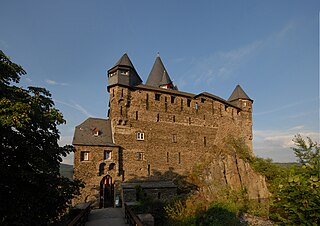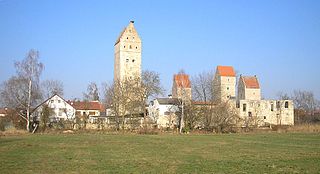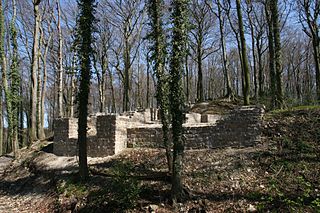History
The water castle was built in the 13th century as the family seat and Ganerbenburg of the lords of Leonrod, who were descended from the lords of Buttendorf, in order to protect an important road link to the city of Nuremberg. The castle was first mentioned in 1235 with a Rudolf miles de Lewenrode.
In the 14th and 16th centuries structural changes were made to the castle. The castle survived the Thirty Years' War unscathed, but shortly afterwards, in 1651, it burned down as a result of negligence - attempts to burn off vegetation in the moat got out of hand - and it was never rebuilt. In the 17th and 18th century a hunting lodge was built. The castle is owned today by a community of heirs that go back to the aristocratic line that died out in 1951.
One of the members of the nobile family was Franz Leopold, Baron of Leonrod, who was Bishop of Eichstätt from 1867 to 1905 and is one of the most important bishops of this diocese.

Finkenstein Castle is a ruined medieval castle in the market town of Finkenstein, in the Austrian state of Carinthia. It is situated on a steep cliff at the southern foot of the Karawanks mountain range, high above Lake Faak, at a height of 788 metres (2,585 ft). Today the castle ruin is the backdrop of the Burgarena, an amphitheatre with 1150 seats mainly used for concerts and festivals.

A shield wall, also shield-wall or Schildmauer, refers to the highest and strongest curtain wall, or tower of a castle that defends the only practicable line of approach to a castle built on a mountain, hill or headland. German sources may refer to a shield wall that protects two or more sides as a Hoher Mantel or Mantelmauer, which is variously translated as "mantle-wall", "mantle wall" or "high screen-wall". There is often no clear, definitive distinction between a shield wall and a mantle wall.
A Ganerbenburg is a castle occupied and managed by several families or family lines at the same time. These families shared common areas of the castle including the courtyard, well, and chapel, whilst maintaining their own private living quarters. They occurred primarily in medieval Germany.

Windeck Castle, also Old Windeck Castle, is a ruined Black Forest spur castle which stands on a 378-metre-high spur in the Bühl district of Kappelwindeck, in the county of Rastatt in the German state of Baden-Württemberg.

Leonrod is a village in the borough of the market town of Dietenhofen in the district of Ansbach, Middle Franconia, Germany.

Scherenburg Castle is a ruined hill castle at an elevation of 200 m above sea level (NN) which stands on a hillside above the town of Gemünden am Main in the province of Lower Franconia in the German state of Bavaria.

A tower castle is a small castle that mainly consists of a fortified tower or a tower-like structure that is built on natural ground. It is thus different from the motte-and-bailey castle, which it may resemble, but whose main defensive structure is built on a motte or artificial hill. The tower castle is occasionally also described as a tower house castle or a tower house.

Wellheim Castle is a former fortification in Upper Bavaria. The ruins of the old rock castle stand dominantly on Jurassic rocks above the market town of Wellheim in the ancient Danube valley. It was abandoned in the 18th century and partially demolished.

Falkenstein Castle, also called New Falkenstein (Neu-Falkenstein), is a ruined hill castle at 450 m above sea level (NHN) in the eponymous climatic spa of Falkenstein, a quarter of Königstein im Taunus in the county of Hochtaunuskreis in the German state of Hesse.

A butter-churn tower is a two-part defensive tower in which the upper section has a smaller width than the lower section.

The ruins of the Thurant Castle stand on a wide slate hill spur above the villages of Alken on the Moselle in Germany. The castle is in the district of Mayen-Koblenz in Rhineland-Palatinate and belongs to the spur castle type. Vine gardens on the sunniest slope.

Schauenburg Castle is a ruined hilltop castle located in Oberkirch, Germany, atop a 367-metre-high (1,204 ft) (NN) hill spur overlooking the Rench river valley above the town of Gaisbach, Baden-Württemberg. The castle was built by Duke Berthold II of Zähringen.

Neideck Castle is a former high mediaeval nobleman's castle above the village of Streitberg, in the municipality of Wiesenttal in the Upper Franconian county of Forchheim in the German state of Bavaria. As a result of its exposed location above the valley of the Wiesent, it has become a symbol of Franconian Switzerland.

Waischenfeld Castle is a ruined rock castle on a rocky plateau a few metres west of the town of Waischenfeld in the province of Upper Franconia in the German state of Bavaria.

Schloss Kunreuth is situated on the northwestern edge of the eponymous village of Kunreuth which is part of the collective municipality of Gosberg in the county of Forchheim, in the province of Upper Franconia in the south German state of Bavaria.

Nassenfels Castle stands at the edge of the market village of Nassenfels in the county of Eichstätt in Upper Bavaria. The former water castle is still lived in and may only be viewed from the outside.

The Holter Burg is the oldest castle site in the municipality of Bissendorf near Osnabrück in the German state of Lower Saxony. It is the ruin of a hill castle. It was the third hill castle in Osnabrück Land along with the Iburg and the Wittekindsburg near Rulle.

The Brömserburg is a castle located near the banks of the Rhine in the town of Rüdesheim am Rhein in Rheingau-Taunus-Kreis in the German state of Hesse. Its original structure was probably one of the first stone castles in the Rhine Gorge, now a UNESCO World Heritage Site.

The Oberburg at Kobern, also called the Oberburg or Altenburg, is a hill castle above the municipality of Kobern-Gondorf in the county of Mayen-Koblenz in the German state of Rhineland-Palatinate.

Haselstein Castle is a ruined hill castle near the village of Haselstein in Nüsttal in the county of Fulda in Hesse, Germany. It lies next to the village on a steep basalt cone at a height of 434 m above sea level (NN). The rock was first mentioned in 780/781 as the Haselahastein.





















